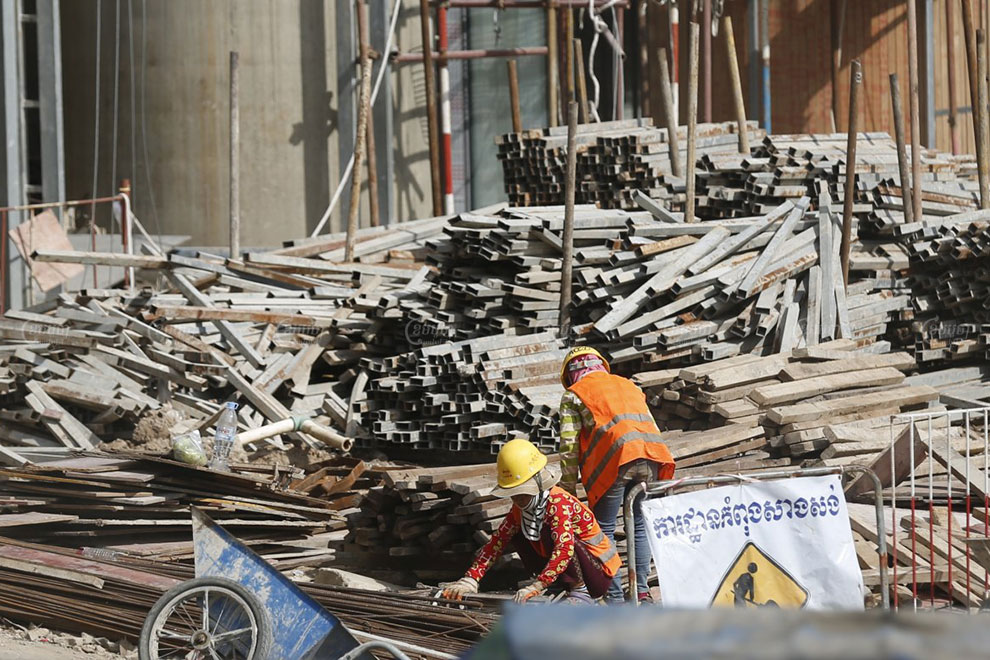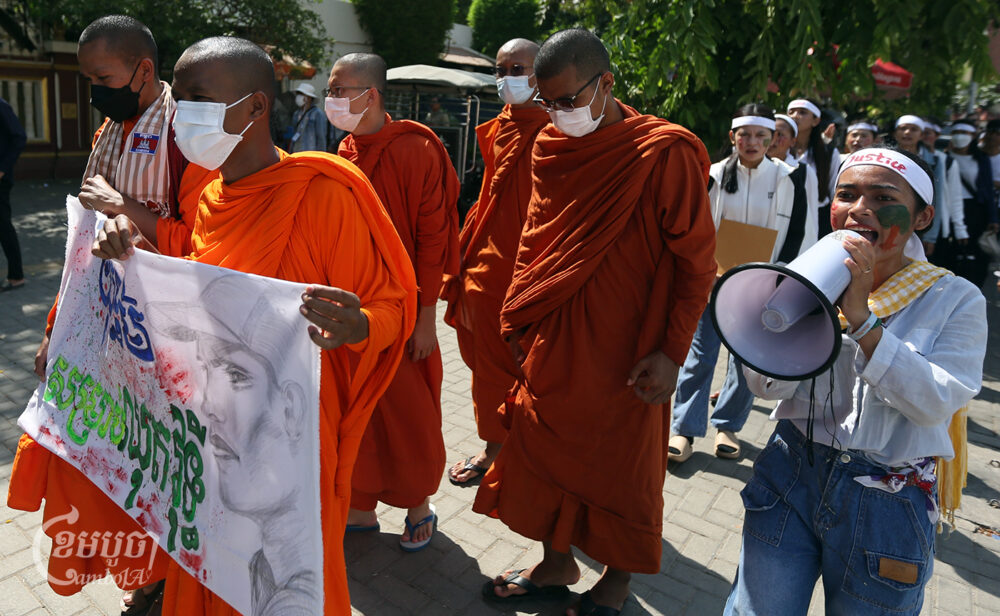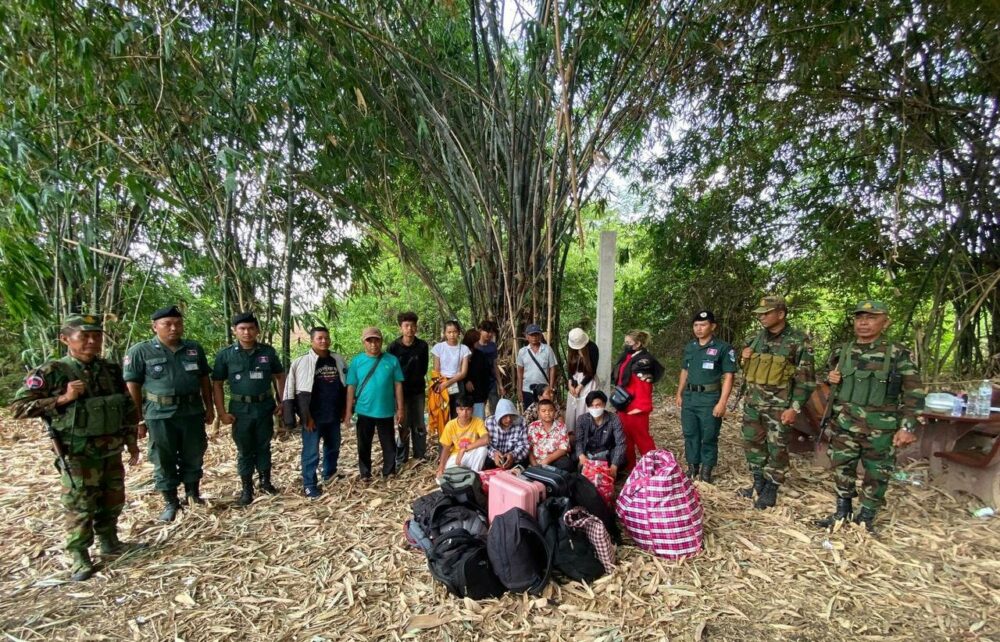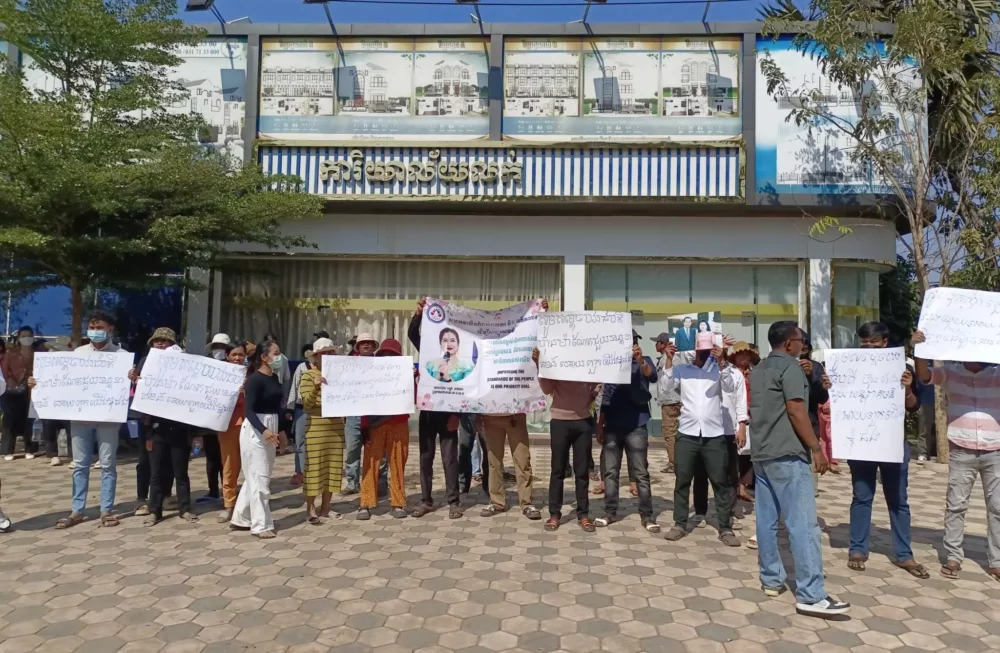Wearing a safety helmet and a bright orange construction worker’s vest, Tha Sreyroth was not alone as she left a jobsite near Wat Phnom on October 1. She was in the company of more than a dozen other women laborers, a sight that has become increasingly common this year in an industry usually dominated by men.
Sreyroth, 26, said she had started construction work after she was forced to leave her job at a footwear factory in Kandal province when the facility, along with hundreds of others nationwide, suspended operations due to the Covid-19 pandemic.
“My contract was terminated at the footwear factory in March during the spread of coronavirus and I returned to rest at my homeland for several months,” Sreyroth said.
She soon found a new job at the building site on Sisowath Quay near Wat Phnom in Daun Penh district.
“I came to work at this construction site a month ago because I need money to support my 9-year-old daughter and family,” Sreyroth said, adding that her sister had also joined her at the jobsite, where they both work as cleaners.

“My younger sister and I decided to come work here because we could not find another job at a garment or footwear factory,” she said, adding that she preferred working in the garment industry because construction workers are not given benefits and do not have a set minimum wage.
Although the new job comes with less pressure than her work at the factory, where she was employed for two years, she said the pay cut was a tough blow.
“For women, the work at a construction site is not very different from the work in the garment and footwear factories but it is different when it comes to the salary,” she said. “I get a salary of between $150 and $200 for construction work but I can get a salary of between $200 and $300 per month [at the factory].”
Khun Tharo, program manager at labor rights group Central, said that normally, Cambodia’s construction sector employs about 200,000 workers, but that the number had dropped slightly this year as some construction sites also suspended operations. About 35 percent of the workers are women, and are usually given less strenuous tasks, such as cleaning, mixing lime mortar, and carrying cement or bricks, he said.
“Generally, in the construction sector, there is a lot of discrimination against women workers even though women have the skill to work, foreman and job site leaders often do not provide them with the opportunity to use their skills,” Tharo said, adding that workers who became pregnant would also be immediately fired.
Mam Chhunnang, 30, a safety officer at the 11-story building where Sreyroth has worked, said that of the 500 workers there, about 200 were women.
Many of them had told him they were victims of mass lay-offs at garment factories earlier this year due to Covid-19.
“The number of women who work at construction sites has increased during the Covid-19 pandemic because the factories closed and some workers had their contracts terminated,” he said.
Although some people who are unfamiliar with construction work may think it is too difficult for women, Chhunnang said he had noticed that manyof the new-hires preferred the work to the former factory jobs, as there is less pressure from managers as is common in the garment industry.
Mach Kanha, 23, said she had worked in a Phnom Penh garment factory for five years, but left in April when the factory suspended operations, turning instead to a physically demanding job making bricks at a kiln in Kandal province’s Mok Kompol district.
“I was more satisfied with my work at the garment factory rather than the brick kiln because the factory offered many benefits,” Kanha said. “Garment factory workers also receive a higher salary than the salary at the brick kiln.”
Ath Thorn, president of the Cambodian Labor Confederation (CLC), said that as long as the global Covid-19 outbreak persists, the job losses among garment workers will continue to grow.
“As they lose their jobs and can’t find new work in the garment sector, they will find jobs in other sectors including construction,” he said. “Normally, the jobs in other sectors are not permanent work and sometimes, there is no clear management system and the workers lose out on benefits.”
He said that recently, former garment industry employees who are out of work have been moving into agriculture and construction.
“I think that for them to have job stability, whatever we do, the government should work toward regaining Cambodia’s full tariff-free trade status to the EBA,” Thorn said.
He said the government must also review all of the factory closures this year, as it was unclear whether some owners had merely used Covid-19 as an excuse to shut down their already-struggling factories without paying workers.
According to a Labor Ministry report on August 26, a total of 491 factories have suspended operations this year, and more than 290,000 workers, about 240,000 of whom are women, were left unemployed.
Labor Ministry spokesman Heng Sour could not be reached for comment on October 2.
Sok Kin, president of the Building and Wood Workers Trade Union Federation of Cambodia, said the number of women in construction had significantly increased this year.
“Recently, I have seen many garment workers going to work in the construction sector after their factories closed and their contracts were not renewed,” he said.
In addition to lower wages and a lack of benefits, he said the safety standards in the construction industry were also very difficult to monitor.
“Construction work takes a lot of energy and the worksites are tall and it is very dangerous,” he said. “If they don’t do the work carefully, they will be in danger and could lose their lives.”
Kin said that he hoped the new shift toward construction work and away from the garment industry would prompt the government to review the enforcement of safety standards and consider setting a minimum wage for the industry.
“The government should review the minimum wage because if they do not set a minimum wage, they should make clear guidelines to set a daily fee for construction workers,” he said.
Tharo of Central, said the number of garment workers who have transitioned into construction work is small compared to the number who returned to their hometowns to work in agriculture after their factory contracts were terminated.
However, he noted that it is difficult for garment workers to move to any new job, as they have only been trained in one specific skill set, so they have little choice but to accept worse pay in sectors like construction.
“This becomes a hurdle for garment workers when they need to change their job because they are not professional skilled workers,” Tharo said.
Tharo said that according to Central’s numbers,180 factories were still suspended as of August, affecting hundreds of thousands of workers.
“According to Central’s figures, about 20 factories have closed, affecting nearly 40,000 workers,” he added.
He said that if Covid-19 disease persists globally, the garment sector will not recover soon.
“At the same time, other work opportunities are also reduced,” he added, referring to the loss of tourism business and the shutting down of some major construction projects.
Tharo said that according to the Cambodia Constructors Association, about 90,000 construction workers had also lost their jobs amid Covid-19.
“Garment workers who lose their jobs cannot find better working conditions because the construction industry does not have a National Social Security Fund and minimum wage like the garment industry,” Tharo said. “In particular, occupational health safety is a major challenge and women who work in this sector are in danger of sexual harassment and are not given time off to deliver a baby.”
Kaing Monika, deputy secretary-general of the Garment Manufactures Association in Cambodia (GMAC) said that garment factories were no longer facing issue sourcing raw materials for products, and that orders had also increased a little since earlier in the year.
“Now, the situation [in the garment industry] is slowly getting better,” he said, adding that there was no way to avoid the loss of jobs in the industry.
Monika also said that GMAC had filed a complaint with the European Court of Justice against the European Union, asking it to annul its decision to partially suspend Cambodia’s participation in the “Everything But Arms” tariff-free trade plan, and that the European Court of Justice is processing the case.
“Our case was received by officials and the court has started the procedure,” he said, adding that he does not know how long it will take for the court to make its decision.
“We are trying our best because this is the last available avenue for us to protect the rights and interests of our members,” he said.
For her part, Sreyroth said she hoped the factories would find a way to reopen again so that she could return to work that she was familiar with.
“I request [the government] to help garment factories begin operating again because women working at the factories receive much better benefits than in other sectors,” she said.








